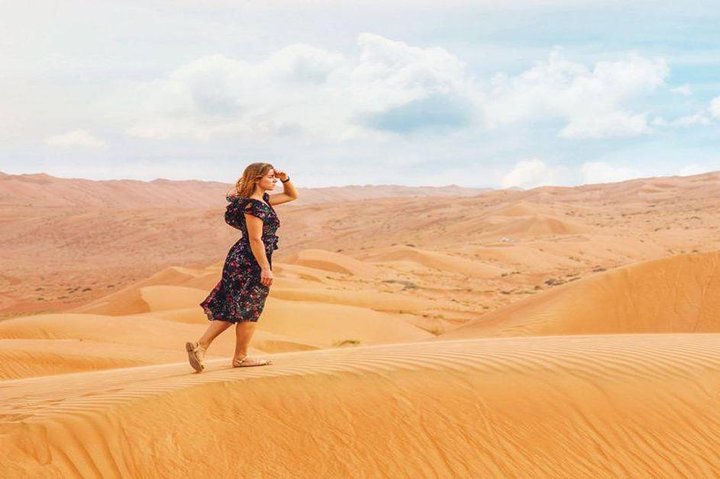First Light on the Red Dunes: Dubai’s Morning Desert Safari
Dune bashing, sandboarding, and a camel’s-eye view—before the city wakes.
The city is still yawning when your driver eases off the highway toward the open desert. Sodium streetlights fade behind you, and the dunes rise like sleeping giants, their shoulders blushing at the first hint of sun. At the edge of the Lahbab Red Dunes, the 4x4 hisses as the tires sigh out air—traction is currency in soft sand—and the morning wind flicks a cool ribbon around your cheeks. Out here, the day starts simple: light, sand, horizon. And then it moves.
Trail Wisdom
Hydrate Early and Often
Drink before you’re thirsty and carry at least 1 liter per person for a morning outing.
Dress for Sand and Sun
Wear UV-rated sunglasses that seal well, a brimmed hat, and a light scarf or buff to block windblown sand.
Footwear Matters
Closed-toe shoes or secure sandals stay put in soft sand and protect your feet while boarding and climbing.
Motion Savvy
If you get carsick, take ginger or bands 30 minutes prior; request a mid-row seat for the smoothest ride.
Local Knowledge
Hidden Gems
- •Al Madam ‘Ghost Village’ near the desert edge for eerie, sand-drifted photos
- •Fossil Rock (Jebel Maleihah) viewpoints for geologic drama and wide horizons
Wildlife
Arabian gazelle, Desert fox
Conservation Note
Stick to established driving zones, pack out every scrap, and never disturb ghaf trees or desert shrubs—this fragile landscape recovers slowly.
Bedouin caravans once traversed these corridors en route between inland oases and the Gulf, a lineage echoed today in camel culture and coffee hospitality.
Seasonal Guide
spring
Best for: Cooler mornings, Clear views
Challenges: Occasional windy shamal days, Rising midday heat
March–May brings comfortable dawn temps and crisp visibility; start early to beat the warming trend.
summer
Best for: Empty dunes, Fiery sunrise color
Challenges: Extreme heat, Rapid dehydration
June–September is hot even at dawn; go pre-sunrise, wear sun protection, and keep the outing short.
fall
Best for: Stable weather, Golden light
Challenges: Dust haze on some days, Warm temperatures linger
October–November is a sweet spot as heat fades; haze can flatten photos, so aim for the clearest mornings.
winter
Best for: Cool comfort, Peak visibility
Challenges: Chilly pre-dawn, More demand for tours
December–February offers the most comfortable rides and brilliant light; pack a light layer for the early start.
Photographer's Notes
What to Bring
Sunglasses with Side CoverageEssential
Wraparound or side-shielded shades keep windblown sand out of your eyes during dune bashing.
Lightweight Neck Gaiter or ScarfEssential
A buff protects your face from sun and sand and doubles as a lens cloth in a pinch.
Closed-Toe ShoesEssential
Secure footwear keeps sandboarding comfortable and protects feet on hot or coarse surfaces.
Compact Daypack
Stash water, sunscreen, and a spare layer while keeping hands free for boarding and photos.
Common Questions
What time does the morning desert safari typically start?
Pickups usually begin around sunrise, with hotel collection from Dubai, Sharjah, or Ajman and a total experience length of about 3.5–4.5 hours.
Is quad biking included?
Many tours offer quad biking as an optional add-on in a designated area; check inclusions when booking if you want to ride.
Is this activity suitable for children?
Yes, families are welcome, but children must use proper seats and belts; very young kids and those with motion sensitivity may prefer gentler dune routes.
What should I wear?
Light, breathable clothing; closed-toe shoes or secure sandals; sunglasses; and a hat or scarf. Avoid loose items that can blow away.
Are there restroom facilities?
Facilities are available at the meeting area or a nearby stop before entering the dunes, but none out on the sand itself.
Can pregnant travelers or those with back issues join?
Dune bashing is not recommended for pregnant travelers or anyone with serious back or neck problems due to the bumpy, dynamic ride.
What to Pack
Insulated water bottle (stay ahead of desert dehydration); UV sunglasses with side coverage (sand and glare protection); Lightweight scarf or buff (blocks windblown sand and sun); Closed-toe shoes (secure footing for sandboarding and hot sand).
Did You Know
The Red Dunes get their color from iron oxide in the sand—erosion from the Hajar Mountains carries iron-rich particles that stain the grains a deep rust tone.
Quick Travel Tips
Eat a light snack before the ride to minimize motion sickness; Bring a microfiber cloth to wipe sand off camera lenses and phones; Avoid loose jewelry and wide-brim hats that can blow away; Confirm whether quad biking is included or an add-on before booking.
Local Flavor
Crave something local after the dunes? Head to Al Fanar Restaurant & Cafe for traditional Emirati dishes like machboos and luqaimat, or sip karak tea with fresh regag bread at a neighborhood cafeteria in Al Qusais. For a cultural cooldown, wander the shaded lanes of the Al Fahidi Historic District and the Coffee Museum.
Logistics Snapshot
Closest airport: DXB (Dubai International). Dunes: Lahbab Red Dunes area, ~45–60 minutes from Downtown Dubai via E44. Cell service: Spotty in the dunes; download maps and keep meeting details handy. Permits: None required for guests—operators handle access. Start early, wear sun protection, and expect a 3.5–4.5 hour round-trip with hotel pickup.
Sustainability Note
Desert soils and shrubs are fragile—ride only with reputable operators who stick to designated zones, pack out all waste, and avoid disturbing wildlife and ghaf trees. Refill a reusable bottle to cut single-use plastic.
Continue Reading

The Pulse of the Gulf: Exploring Cabo Pulmo’s Living Reef
A living reef that fought its way back: Cabo Pulmo is a compact, community-protected marine park where coral gardens and pelagic encounters reward deliberate travel. Here’s how to see it responsibly.
Cabo Pulmo, Baja California Sur

Under the Limestone Roof: Exploring Cenotes Sac Actun’s Subterranean Rivers
Descend into the Yucatán’s submerged cathedral: Sac Actun’s cenotes offer crystalline snorkeling, hushed caverns and a direct link to Maya water lore—best experienced with a local guide and a careful eye.
Tulum, Quintana Roo

